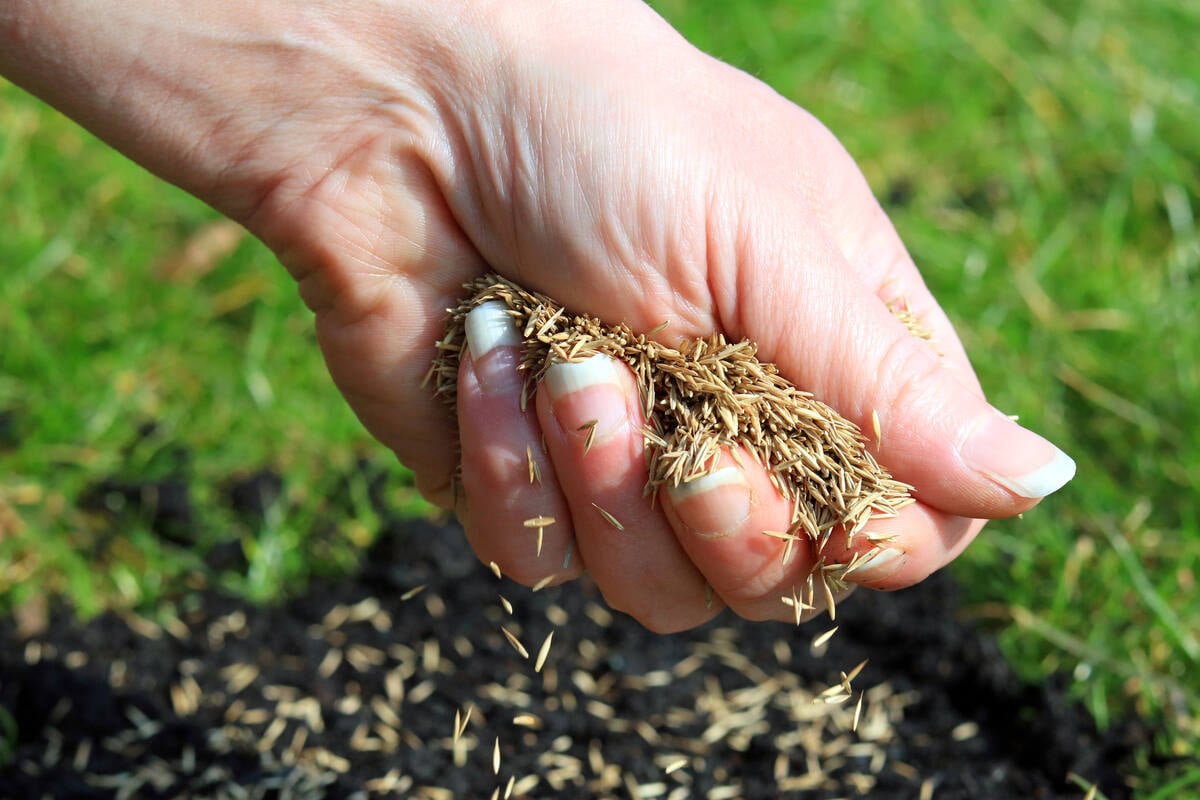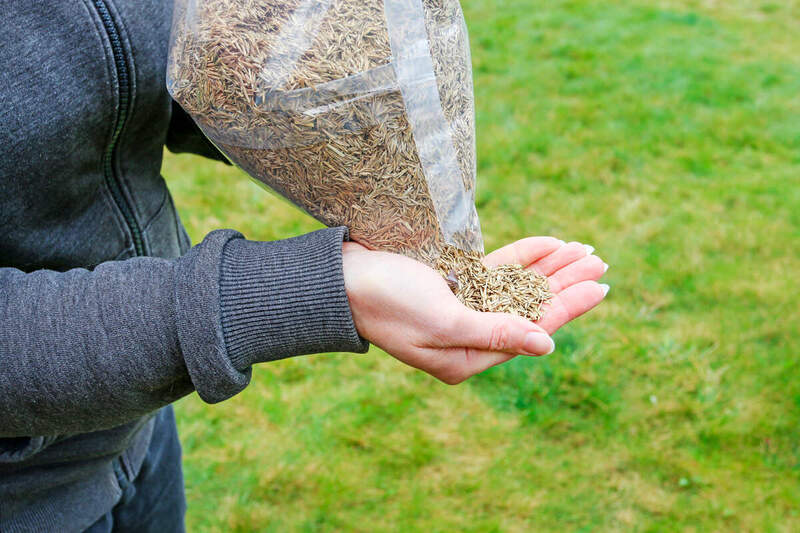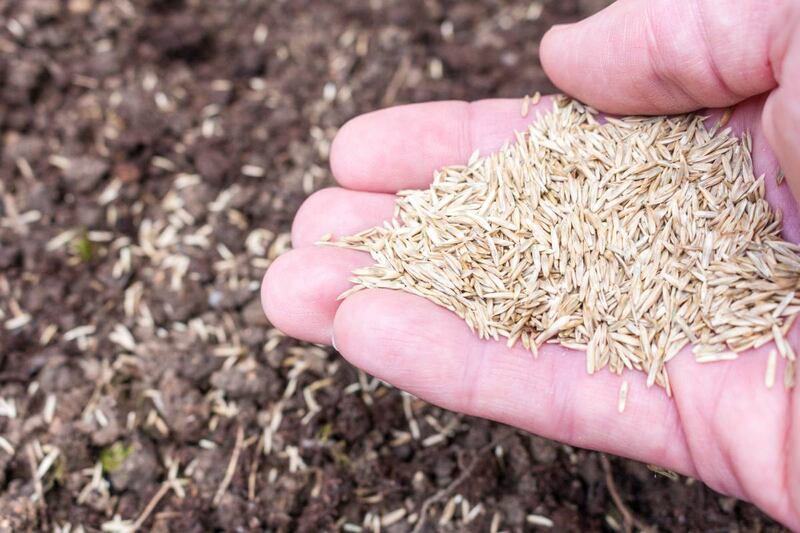
Does grass seed go bad? Yes. You can tell if your grass seed is still good by inspecting 4 basic things: sight, smell, feel, and weight. Seeds that have consistent color and a fresh smell are likely still usable.
After taking your grass seed out of storage, a thorough inspection should easily reveal whether the seed is still good or if you need a new bag. If your grass seeds show no signs of going bad, there are some simple tests you can perform to check their viability.
Does Grass Seed Go Bad?
Yes, grass seeds can go bad over time, especially if they’re not stored properly. The following factors can affect the shelf life of grass seed:
- Seed quality: Better processing and packaging help high-quality grass seeds last longer and withstand storage over time. While they cost more, they contain fewer immature, broken, or non-viable seeds.
- Temperature: The ideal temperature range for storing grass seed is around 40 degrees F to 60 degrees F. Extreme heat can reduce germination potential and accelerate seed deterioration.
- Moisture: Excess humidity is one of the fastest ways to ruin grass seed. When seeds absorb moisture, they may develop mold or sprout prematurely.
- Airflow: Dry seeds should be kept in airtight containers to prevent airflow, which can introduce moisture and reduce seed viability.
- Light exposure: Grass seed should be kept in a dark location to preserve its dormancy. Too much light can trigger early germination or cause the seeds to dry out.
- Pests and mold: Rodents, insects, and mold can easily infest stored seeds if not sealed and protected. Contaminated seed not only loses viability but can also introduce disease into your lawn.
Under the right storage conditions, seeds can remain viable for 2 to 5 years, depending on the type of grass. Cool-season grass seeds typically last longer than warm-season grass seeds.
| Grass Type | How Long Seeds Last |
| Warm-season grasses (bahiagrass, Bermudagrass, buffalograss, centipedegrass) | 2 to 3 years |
| Cool-season grasses (fine fescue, Kentucky bluegrass, perennial ryegrass, tall fescue) | 3 to 5 years |
4 Signs Your Grass Seed is Still Good

If stored incorrectly or left for too long, grass seed can expire and lose its viability. If you try to plant expired grass seed, you’ll only wind up wasting time, energy, and resources on a lawn that won’t grow.
When you’re about to plant your new lawn, stop and take a moment to inspect your seeds. Pay close attention to their color, smell, feel, and weight. Here’s what you should be looking for:
1. Seeds are Uniform in Color
The first way you can tell if grass seeds are still good is with a visual inspection. Take a handful of grass seed and go over it with a close eye. See if there are any changes in its physical appearance.
What to Look For: Grass seeds that are still good to plant will look vibrant. They should be uniform in color across the bag with no signs of mold or fungus.
What to Avoid: Grass seed that’s gone bad looks discolored. Watch out for any seeds that are splotchy, faded, or dull. Some grass seeds become darker in color if they’ve expired. You may even be able to see visible mold or fungus, which is a sure sign that the seed is no longer viable.
2. Seeds Smell Fresh
The next step in inspecting your grass seeds is a smell test. Take a big whiff of your seeds.
What to Look For: Grass seed that’s still good will smell fresh. If you have already used some of them previously, try and remember what the seeds smelled like when you first bought the bag.
What to Avoid: If grass seeds have gone bad, they typically smell musty, or even rotten. Sometimes, you’ll notice a smell like something has started to ferment. If the seeds smell at all off, they’re likely no good.
3. Seeds Feel Solid and Firm
Another way to tell if your grass seed has started to go bad is to feel it. Take some seeds and examine them carefully.
What to Look For: Good grass seeds are firm and strong. If you press them between your fingers, they should feel hard and not break.
What to Avoid: Expired grass seed feels very different from seeds that are still viable. Nonviable seeds may feel mushy or brittle. If you try to squeeze some, you might find that they break easily. If so, the seed has expired.
4. Seeds Have Good Weight
The last thing you should check for when inspecting your grass seed is its weight. This is a bit more difficult to measure since it’s not a sense like sight or smell, but it’s a valuable indicator nonetheless. Take a handful of seeds and try to gauge their weight.
What to Look For: Grass seed that’s still viable is heavier than expired seed. Look for other indicators and judge whether or not you feel the seed is still viable.
What to Avoid: If the grass seeds are lightweight, they might be expired.
How to Test if Your Grass Seed Is Still Good

Of course, it’s possible for grass seed to have lost its viability and show no outward signs. If you’re still unsure after carefully inspecting your grass seeds, you can test them. There are two ways to definitively test whether grass seed is still viable: the float test and germination test.
Once you know your grass seed is still good, you’ll find this guide helpful for planting it: How to Plant Grass Seed.
Float Test
The first method is the float test. Take some seeds and put them in a bowl of water. To make counting them easier after the test, use a multiple of 10; for example, 20 or 30 seeds. If 80 percent or more of the seeds float after 15 minutes, then the bag is still good and you’re good for planting.
If 50 percent or less float, you either need a new bag or need to double the amount of seeds you plant.
Germination Test
The second test is the germination test. This test is more time-consuming than the float test, but also more accurate. Take some seeds and try to germinate them. Just like the float test, use multiples of 10.
Place your seeds on a wet paper towel, seal it in a plastic bag, and put the bag somewhere warm. Wait one week and see if the seeds start to grow. After a week, if 80 percent or more sprout, you’re good.
If 50 percent or less sprout, buy a new bag or plant extra grass seed.
FAQ About Grass Seed
Likely not. If only the packaging got wet, you can dry it off and store the bag correctly. If the seeds themselves got wet and then dried out, they’re probably either already expired or will expire soon.
No. Once grass seed has spoiled, you can’t bring back its viability.
It’s generally not recommended to use old grass seeds because fewer seeds will germinate, and you’ll end up with patchy or uneven growth.
It’s not a good idea to store grass seeds in the garage unless the space is consistently cool, dry, and pest-free. Fluctuating humidity and temperatures can reduce the seed’s shelf life.
Find a Lawn Care Expert
You should always inspect your grass seed carefully before trying to plant it. If you accidentally use bad seeds, you can expect a patchy, unhealthy lawn.
If you need help with your grass, contact lawn care professionals near you. They can mow and maintain your lawn for you so that you have more time to yourself.
Sources:
- “Finding the Right Grass Seed.” By Eric Watkins, professor, turfgrass breeding and genetics. University of Minnesota.
- “Maintaining Grass Seed Viability in Storage.” By Sabry Elias, professor, Adriel Garay, seed laboratory manager, Bill Young, Extension specialist, and Tom Chastain, professor emeritus. Oregon State University.
Main Image: A person checks to see if grass seed is usable. Image Credit: dean / Adobe Stock Free / License